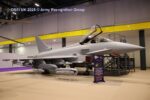At the NATO-led REPMUS 2025 exercise in Portugal, the Austrian-made Schiebel CAMCOPTER S-100 vertical takeoff and landing (VTOL) unmanned aerial vehicle (UAV) demonstrated its latest maritime intelligence, surveillance, and reconnaissance (ISR) capabilities. With upgraded sensors and seamless integration into naval command-and-control networks, the S-100 reinforced its position as a mature and deployable solution for maritime domain awareness across NATO fleets.
REPMUS 2025: A Crucial Testbed for Emerging Maritime Tech
REPMUS (Robotic Experimentation and Prototyping using Maritime Uncrewed Systems) is an annual NATO exercise hosted by Portugal that focuses on integrating uncrewed systems into naval operations. The 2025 edition involved over 25 nations including key NATO members such as the United States, United Kingdom, France, Germany, Italy, and Canada. The exercise featured more than 50 uncrewed systems across surface (USV), subsurface (UUV), air (UAV), and hybrid domains.
The CAMCOPTER S-100 participated as part of a larger effort to evaluate how VTOL UAVs can enhance real-time situational awareness for naval task groups. The platform was deployed from a Portuguese Navy vessel operating off Troia Peninsula in southern Portugal. The demonstration focused on multi-domain interoperability under NATO’s Federated Mission Networking (FMN) framework.
CAMCOPTER S-100 Platform Overview
The Schiebel CAMCOPTER S-100 is a combat-proven rotary-wing UAV designed for both land-based and maritime operations. It features:
- Maximum endurance of over 6 hours with standard payloads
- Operational range up to 200 km (line-of-sight)
- Payload capacity of up to 50 kg
- Typical cruising speed of ~100 km/h
- VTOL capability without launch/recovery equipment
The platform is powered by a heavy-fuel engine compatible with JP-5/JP-8/NATO F44 fuels—an important logistical advantage for naval deployments. Its modular payload bay supports EO/IR sensors, radar systems like Leonardo’s PicoSAR AESA radar or Thales I-Master GMTI/SAR radar, AIS receivers for ship tracking, EW payloads for signal collection or jamming missions, and even small synthetic aperture radars.
Sensors & Payloads Demonstrated at REPMUS
During REPMUS 2025 trials aboard the Portuguese Navy’s NRP Viana do Castelo offshore patrol vessel (OPV), the CAMCOPTER was equipped with a suite of advanced ISR sensors:
- L3Harris WESCAM MX-10 EO/IR turret: Provided high-definition day/night imaging with laser designation capabilities.
- AIS receiver: Enabled real-time tracking of maritime traffic in congested littoral zones.
- Synthetic Aperture Radar/GMTI module: Though not officially confirmed by Schiebel during this trial phase, past deployments suggest compatibility with PicoSAR or I-Master radars for all-weather detection of surface targets.
The sensor feeds were relayed in real time to onboard command centers via encrypted data links. This allowed operators to cue other assets—including manned helicopters or surface vessels—based on live target tracks generated by the UAV.
C4ISR Integration with NATO Networks
A key objective at REPMUS was validating how uncrewed assets like the CAMCOPTER can plug into multinational command-and-control architectures. The S-100 successfully integrated into the Portuguese Navy’s combat management system via standardized interfaces such as STANAG-compliant data formats. Additionally:
- The platform supported Link-16 gateway relay functions via shipboard processors.
- Sensor data was fused into common operational pictures shared across multiple NATO units participating in amphibious task group maneuvers.
This level of interoperability is critical for future distributed maritime operations where manned-unmanned teaming will be essential. According to Schiebel representatives at REPMUS: “The ability to share actionable ISR data across allied platforms in near-real-time is no longer optional—it’s foundational.”
Tactical Use Cases Demonstrated During Trials
The CAMCOPTER executed several mission profiles during the two-week exercise:
- Littoral surveillance: Monitoring small boat activity near coastal chokepoints using EO/IR imagery fused with AIS overlays.
- Tactical overwatch: Providing persistent coverage over amphibious landing zones during simulated raids conducted by USMC and Portuguese Marines.
- Cueing anti-surface warfare assets: Detecting fast-moving contacts beyond radar horizon for OPVs equipped with lightweight missiles or guns.
This versatility underscores why navies are increasingly turning to VTOL UAVs like the CAMCOPTER as force multipliers—especially when operating from ships without full flight decks or hangar facilities.
NATO Adoption Trends & Export Footprint
The CAMCOPTER has already been adopted by several NATO navies including those of France (via Naval Group), Italy (Marina Militare), Germany (Bundeswehr trials), Belgium/Luxembourg joint program under European MALE RPAS initiatives—and now Portugal through this demonstration campaign. Outside Europe it has seen operational use by forces in Australia, UAE, Thailand and Malaysia among others.
Procurement Notes & Industrial Partnerships
- EASA-certified airworthiness: The system holds civilian-type certification enabling dual-use applications including border surveillance or environmental monitoring missions under coast guard authorities.
- Industrial partnerships: In some export markets like India or UAE, Schiebel has explored local assembly/licensing models to meet offset requirements.
- NATO DIANA relevance: The platform aligns with emerging DIANA innovation priorities around autonomous surveillance platforms interoperable within multi-domain operations frameworks.
The Road Ahead: Autonomous Features & AI Integration?
While current missions rely heavily on human-in-the-loop control models via ground control stations aboard ships or onshore nodes—the roadmap for future iterations includes increased autonomy through AI-based target recognition algorithms. Trials involving onboard processing modules capable of automatic classification of vessels based on EO/IR imagery are reportedly underway within EU-funded research programs such as OCEAN2020 follow-ons or PADR initiatives under EDF funding lines.
Persistent ISR Without Carrier Decks?
This trend could make platforms like the CAMCOPTER indispensable for navies lacking aircraft carriers but seeking persistent ISR capabilities over blue-water or littoral zones—especially when paired with USVs acting as motherships or logistics nodes for rearming/refueling UAVs mid-mission cycle.










